Editor’s note: Among the greatest joys at Toque & Canoe are the photos that friends and followers share with us along the way.
The image might be from a lobster fisherman, showing us his recent catch off the coast of Prince Edward Island.
Perhaps it’s a neighbour, who has snapped a photo of a lone moose swimming across a lake during summer.
Or maybe it’s one of our country’s greatest conservation photographers who fires us an image of one of the most handsome grizzlies we’ve ever laid eyes on (see above!).
We’ll never forget our e-mail conversation with Pacific Wild’s Ian McAllister, who was at work on an upcoming book, cruising in his boat along the coastline of Canada’s Great Bear Rainforest (which also happens to be where he and his family live.) He told us he had literally JUST captured an image that perhaps we’d like to share with our followers. Uh, yah—of course we’d like to share!
So here we are, posting Ian’s incredible image once again—but this time along with a selection of photos from his new book, Great Bear Wild, that we thought you might enjoy.
Lucky for us, we got to see Ian present at the Banff Mountain Film and Book Festival in the fall. If you ever get a chance to hear him speak, do yourself a favour and check him out. He has a remarkable story to tell about one of the last wildest places on earth.
(*Photos and text by Ian McAllister)
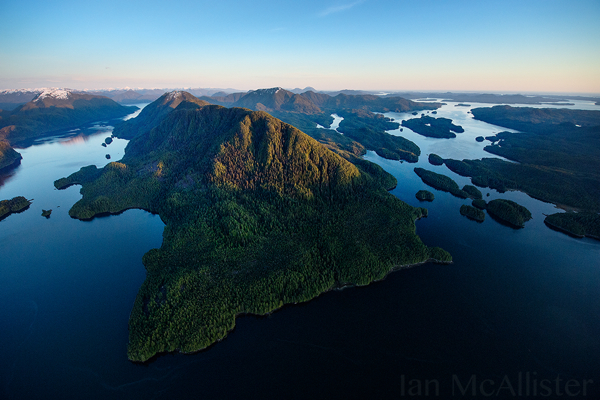
The Great Bear Rainforest is my backyard. It’s full of wolves, grizzlies and black bears and it’s part of the largest tract of intact temperate rainforest in the world. How long will I live here? Well, when I’m away, even though I’ve been here for twenty years already, all I can think about is going home, getting back in my boat and going exploring. I think I’ll be sticking around for a while.
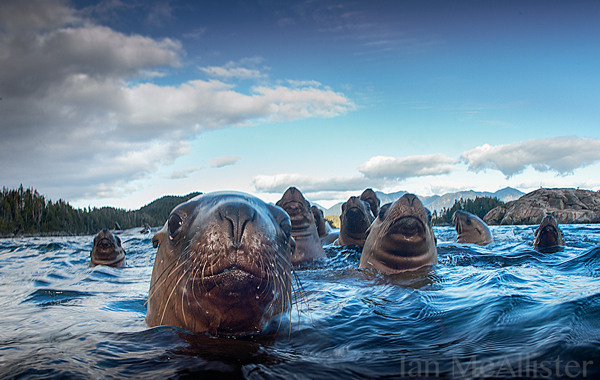
I love hanging out with these guys. Sea lions are super social and playful. They represent the richness of the coast. If there wasn’t a stable food supply for them, they wouldn’t exist. Alaska has seen a collapse of its Steller sea lion population, while here on the B.C. coast our sea lion population is increasing each year.
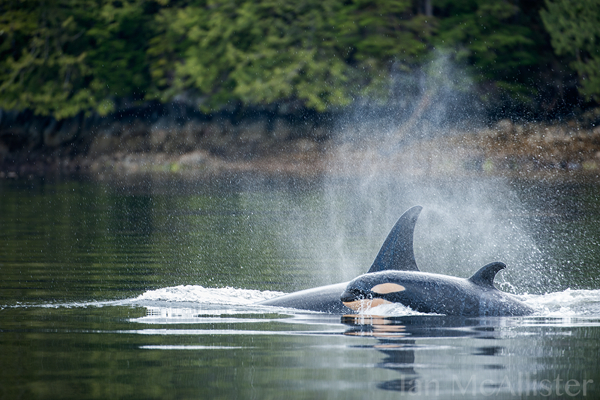
This is a pod of transient orcas. When they come in closer to the shore, especially in the spring, they chase the seals and sea lions right in front of where my family lives. On a calm night, you can hear them blow across miles of water. This family follows the herring cycle, so we see them when the herring start to spawn. This was a grey, misty day and every time these two would surface, the vapour of their breath would lie suspended, sparkling, above the water for a long time.
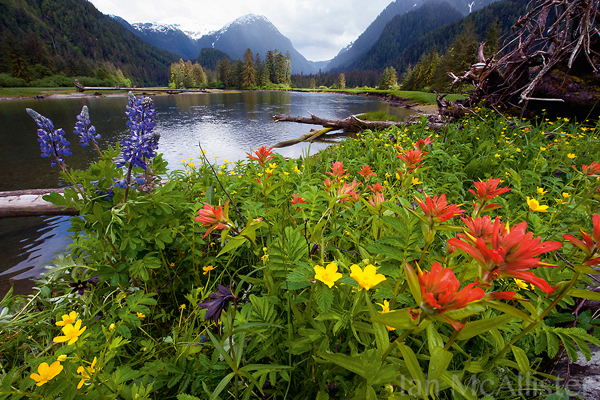
People have commented that there are no seasons in The Great Bear Rainforest. That we go from green to grey to green again. But wildflower season in the estuaries is something else. There’s lots of bear food shown in this image. In fact, estuaries are a smorgasbord for bears. They boast soil that is rich from thousands of years of decaying salmon bodies. Estuaries are considered the heart of the rainforest.
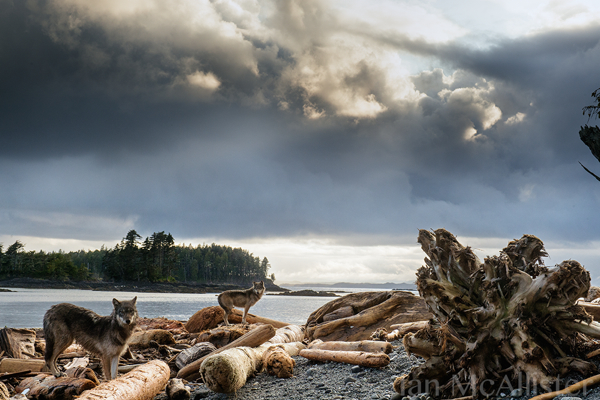
I’ve been spending a lot of time exploring the world of sea wolves, wolves that make their living from the ocean. They prey on marine mammals and eat herring eggs and whale carcasses that wash in with the storms. I know each wolf, individually, and have watched them grow from pups into alpha leaders. They have attributes that humans value within our own species—leadership, the abilities to nurture, protect, show respect and demonstrate reverence. They are highly intelligent.
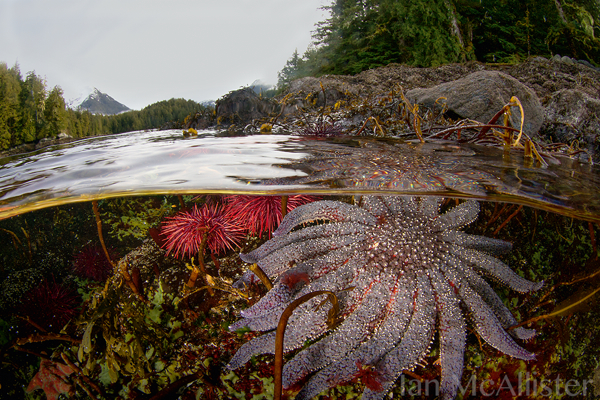
The colours beneath the ocean’s surface are staggering, especially when you combine natural light, high pressure, sunshine and crystal-clear winter waters. What you see almost defies description. People are amazed by the underwater world. It should be noted that this is the last frontier for conservation. Canadians understand the idea of protecting Africa’s Serengeti, South America’s Amazon and Australia’s Great Barrier Reef. Yet for some reason, we aren’t recognizing what a global treasure we have here, right in our own backyard.

I love this picture. I had managed to disappear into the rainforest for a long time. I got to know this favourite fishing spot which was super remote. There were probably close to 30 bears in the area. This family would come walking down the log, like clockwork, every single day. The cubs would cheer on their mother as she caught Coho salmon and, sometimes, the little ones would get so excited they’d fall off the log. Can you see the second cub? No one seems to notice him!
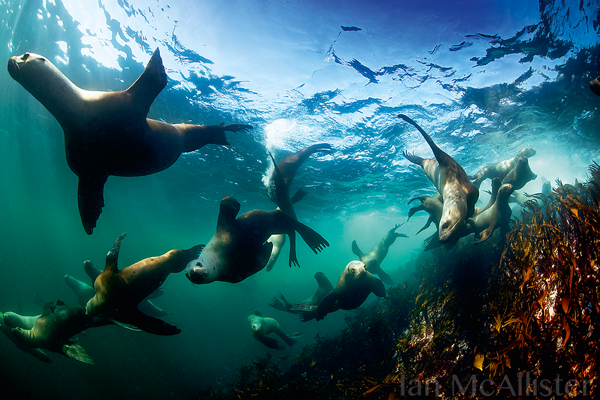
Again, sea lions are like playful puppy dogs but they can also be a little thug-like. It’s so much fun being visited by these guys under water. They’re in their element and they know that you aren’t. They like to use their mouths for feeling and tasting and testing so they nip at you and grab your fins and camera. It can be unnerving. You just have to surrender to whatever comes your way.

This photo illustrates the forest/ocean connection that I’m trying to demonstrate with my images lately. These two worlds are undeniably connected. The sea wolves are so reliant on the ocean and they spend so much time in the water, I wouldn’t be surprised if they’re evolving webbed feet. I love this image, not for its own sake, but for the connection it illustrates. Every single day this pack would be feeding on herring eggs and feasting on the shoreline. I finally had to just jump in the water, swim over and grab the image. It tells the story that there is no line of separation between these two worlds.

Cubs have such love and respect for their mother. Here, they’re copying how she stands and how she stares at the waterfall, waiting for a salmon to leap. Some salmon jump right into her, and she pins them down on a rock. Often she has to grab the fish right out of the air as they’re jumping up and over the waterfall. The mother-cub relationship involves intense loyalty. The cubs will be with their mom, learning about their territory, fishing techniques and other life skills, for two years. Bears can live well into their 20s. What they learn from their mother is critical to their survival.

This was a great day. The whale was upside down most of the time, flipping its tail constantly. We’re celebrating the resurgence of life in this part of Canada and humpbacks are the single dominant species that showcase this resurgence. It used to be rare to see humpbacks and now there are so many it’s almost impossible not to see one. This photo was taken right smack in the middle of a proposed oil-tanker route. This is a spectacular part of the earth and in spite of everything, it’s bucking the trend where so many other ecosystems are headed for collapse.
Why this resurgence is happening on the B.C. coast is unknown. Perhaps it’s because we’ve got one of the last quiet, ecologically-rich oceans left. Maybe many of the species previously hunted to near-extinction have recognized that these waters are safe and that they offer an acoustic refuge where whales can still communicate—unlike in the rest of the world’s busy oceans. What is happening right now, in these waters, is remarkable and it’s making the people who live here all the more protective of the region.


Alouise commented:
These photos are incredible. I love the underwater ones, but especially the split-view one showing below the ocean and above it. What an amazing natural treasure we have here in Canada.
Val Berenyi commented:
Beautiful photos of an achingly beautiful place that is on the mend. Who knew?
darellbear Becker commented:
Thank You Ian and Pacific Wild Team for Bringing Awareness to Our Great Bear Rain Forest and the Spirit Bear , along with the other Endangered Wildlife that is Threatened by Logging of Old Growth Forests and to Stop the Oil Tanker and More ….Always a Warrior to Save Our Mother Earth and Her Miracles…Thank You again from darellbear from Ocean Falls B.C.
Kelly commented:
Wow, Ian, what amazing photos!!! keep up the incredible work in education and conservation! We’re watching!
Linda Cooney commented:
Thank you Ian for bringing our very remote, pristine and treasured, yet threatened, paradise into our awareness and hearts through your love, dedication, commitment, photos and words. You ARE a sea lion in your life’s work, that’s why you love those guys!
Patti C commented:
Wow! So grateful for this extraordinary collection of photo’s – each with such an insightful narrative! The Great Bear has a true champion in Ian McAllister…really one of the finest ecologist’s around!
DJ commented:
Just love all these photos amazing captures thanks for being awesome
LO commented:
OMG – these are GORGEOUS photos. And each vignette he describes makes them even more endearing. They are lovely. Thank you Ian McAllister.
Daniel Egger commented:
I`ve visited the Great Bear Rainforest in 2012 and I`m still in Love with this incredible place!
The photos from Ian are just breathtaking!
He and his team is doing such a great work to protect one of those last remaining ecco systems here on earth…
Gary Mawer commented:
Awsome photography. To capture natural beauty at the right moment is a gift and you Ian have it. Well done!
Elizabeth Mitchell commented:
I first learned about the Great Bear Rainforest and the Great Bear Sea by following Pacific Wild. I would like to thank Ian and Karen McAllister for all of their hard work, and also their team.Ian’s photography has always been awesome! Thank You
Matthew Bailey commented:
Wow, incredible pictures. We’re gearing up for the biggest Canada150 event of the year and can’t wait to make our stop on the West Coast… Likely early October… Wanna show us around for our Canada documentary?